General
In 1870 Sherfield House, a 3-storey house of five bays built around the late 17th century, became the infirmary and staff quarters for the Training Ship Goliath, a wooden sailing ship built in 1835 for the Navy.
The Forest Gate School District, a combination of the Hackney, Poplar and Whitechapel Unions, had been requested by the Local Government Board to establish such a ship to train pauper boys for the sea services. Training was provided by former members of the Royal Navy.
In December 1875 T.S. Goliath was destroyed by fire. The local watermen of Grays showed outstanding bravery in rescuing those on board, but one officer and about 18 boys died in the disaster.
Some 109 boys continued their training in Sherfield House until a new ship could be acquired.
In January 1876 the Local Government Board asked the Metropolitan Asylums Board (MAB) to take over control of the project, thus enabling pauper boys from the whole of the metropolitan area of London to be enrolled. The remaining 17 years of the lease for Sherfield House was transferred to MAB in March 1876 at an annual rent of 100 guineas (£105).
The Infirmary had 46 beds and the staff initially consisted of an infirmary attendant and his wife. Cadets with infectious diseases could immediately be isolated from the other pupils. The Infirmary was also used as a quarantine station for new boys joining the ship; they stayed for one week to ensure they did not bring infectious diseases on board ship.
The Infirmary dealt mainly with disorders of the digestive system, injuries, and eye or skin diseases.
Sherfield House stood in 2 acres of grounds, which were used as playing fields when the boys were off ship in the summer months.
In 1877 the Admiralty loaned the Exmouth to MAB as a replacement for Goliath.
During 1878 the Infirmary dealt with 132 cases of simple dyspepsia (25% of admissions were to do with the digestive system), 134 cases of accidental injuries, 36 patients with tonsillitis, 24 with eye disease, 18 with bronchitis or pneumonia, one case of tuberculosis and one of purpura.
By 1882 there were 600 cadets on board the ship. The cost of the enterprise, including salaries, taxes, lighting and other utilities, medical charges, rent of the on-shore buildings and their furnishings, was £9,730 for the half-year (the weekly cost of provisioning and clothing the boys was estimated to be 7 shillings (35p) per head).
In 1897 MAB purchased Sherfield House and its grounds for £2,870.
In August and September 1900 an outbreak of ophthalmia (severe conjunctivitis) occurred, and 32 boys were transferred to White Oak School for treatment. Slighter cases of the infection were treated at the Infirmary.
In 1905 the Training Ship had 600 cadets and 50 members of staff. The low physique of the pauper children from the Metropolitan Unions still concerned the Captain-Superintendent, especially when compared with that of the country children, who were now admitted when places were not claimed by the Metropolitan Unions.
In 1906 the Infirmary dealt with 966 admissions, but the ailments were of mild character and of short duration. The boys remained in the Infirmary for an average of six days. Those with more serious complaints were transferred to nearby general hospitals (fracture cases were sent to the London Hospital), but occasionally a boy died from tuberculosis or nephritis. A dentist visited twice yearly, later increased to three times a year.
Sherfield House closed in 1907, when the Infirmary moved to the former infirmary of T.S. Shaftesbury in West Street.
Present status (April 2011)
Sherfield House was demolished around 1928. The site was then redeveloped, with the Regal Cinema being built in New Road and the Cooperative Garage in Argent Street. These, too, have now been demolished and replaced by Davall House, Butler House and Greenwood House, a high-rise housing scheme.

Davall House in Argent Street occupies part of the site of Sherfield House.
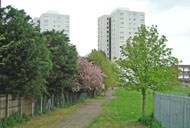
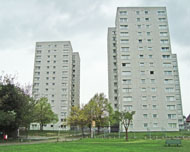
Looking north from river bank along the path to the housing estate (left). The housing estate occupies the site of the Infirmary and playing field (right).
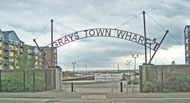
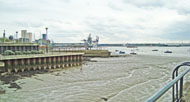
The dock inlet for Grays Town Wharf.

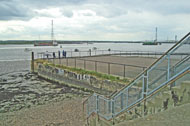
The stub of the Exmouth's pier still remains.
Named after Viscount Exmouth, Admiral Sir Edward Pellew (1757-1833), she initially saw service in the Baltic during the Crimean War (1853-1856).
In 1877 the Admiralty loaned the Exmouth to MAB. She accommodated 750 cadets and staff under the command of Staff Commander William Sutherland Bourchier, formerly of T.S. Goliath.
Most cadets were discharged at the age of 16 to the army or merchant marine (the Royal Navy did not accept boys under 5 ft (1.5 metres) in height).
In 1903 the hull of the Exmouth was found to be unsound and it was felt that the ship was too old for service. She was removed in 1905 and the cadets were sent to Gore Farm, where they camped for six months until a new vessel was ready. They returned in August of that year to the newly launched, purpose-built training ship Exmouth, which was of similar appearance to its predecessor but made of iron and steel.
In 1906, when T.S. Shaftesbury left Grays, the new T.S. Exmouth took over her berth.
(Author unstated) 1904 Training ship "Exmouth". British Medical Journal 2 (2284), 930.
http://en.wikipedia.org
http://gallery.e2bn.org
http://gallery.nen.gov.uk (1)
http://gallery.nen.gov.uk (2)
http://seax.essexcc.gov.uk
www.angelfire.com
www.british-history.ac.uk
www.britishpathe.com
www.bygonegraysthurrock.co.uk
www.cityoflondon.gov.uk
www.donne.free-online.co.uk
www.fotw.net
www.merchant-navy.net
www.nmmprints.com
www.pdavis.nl
www.portcities.org.uk
www.thurrock.gov.uk
www.thurrock-community.org.uk
www.vandekar.com
www.workhouses.org.uk
www.worldnavalships.com
Return to home page